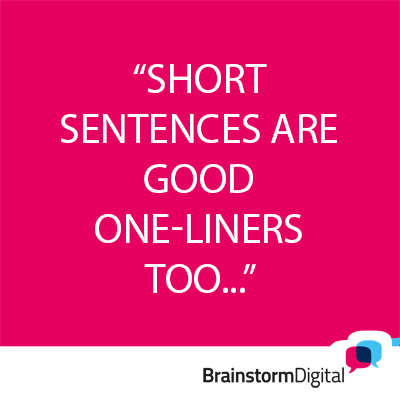
I don’t normally get into arguments on social media… Well, not on LinkedIn anyway. I save those for Facebook 🙂
But recently I made an exception.
Somehow, a post appeared on my LinkedIn feed making fun of people who write short paragraphs, often consisting of just one line, on social media and on email. The post got over 2,500 likes and there were more than 250 comments, mostly supportive.
The tone was sneering. The general gist was that short paragraphs are a sign of dumbing down and illiteracy.
Apparently ‘proper writers’ would never write such short paragraphs. Those are only for people with short attention spans and a low reading level.
And to make his point…
The esteemed adjunct professor who started the whole discussion….
Wrote his post like this.
Geddit??
Well, I couldn’t hold back, because the whole discussion was just pure snobbery. Most people responding to that post believed that the only way to write well was the way they were taught in high school and university, in big chunks of text.
But here’s the harsh truth.
There’s a reason why people – marketers in particular – use very short sentences on social media and on email.
They want to sell. And they understand better than anyone that if you want people to read you on a screen, you have to write differently to the way you do on a printed page.
These are two very different mediums.
First, scientific studies have shown that reading on a screen, whether it’s a computer, tablet or mobile, is more physically and mentally taxing than reading in print. People tend to read more slowly and comprehend and remember less.
One obvious culprit is the glare of light off the screens.
Another reason is that printed material has a landscape which helps readers make sense of the text.
There are two sides of the page, upper corners and lower corners and paragraphs (usually) begin on new pages. This ‘topography’ makes the text easily navigable and help readers naturally map out the text in their mind.
Online, you have one looooong block of text to scroll through. Everything looks the same and there are no natural breaks. It is harder to navigate the text intuitively and harder to find information.
So never mind the classical rules of writing. We need a lot more signs and signals, such as sub-headings and bullet points, to give the text some shape. It also helps if there are a lot more breaks… Or shorter paragraphs.
The same studies also show that people treat reading on screen less seriously than they treat reading print. They tend to read books or print in-depth, but scan web pages and emails for important information.
Again, breaking up the text into smaller chunks helps them do that.
The upshot is that a 12-line paragraph looks fine in a book, but on your mobile it looks as daunting as War and Peace.
I recommend short paragraphs of no more than three sentences, although if each paragraph is exactly three sentences it can get boring.
Try mixing it up a little with a three-sentence paragraph, a couple with two sentences, and every now and then you can be super-daring and write a paragraph that is made up of just one long sentence.
(Like that one.)
Short sentences are good one-liners too…. 🙂
If you’re like my LinkedIn co-debater and think that this isn’t proper writing, feel free.
Ultimately, marketing writing is about what works, not what your English teacher taught you. Are you here to sell products, or to earn an A*?
If you raised your hand for the former, start shortening paragraphs in your email newsletters and online content.
And to make sure that the content in every email you write is designed to sell as well, click here.
Miriam Shaviv is director of content at Brainstorm Digital, which helps companies generate enquiries and sales over email. Check out Inbox Express, our library of email templates to turn your email subscribers into paying clients. And get a sneak preview of some of the templates here.






